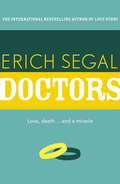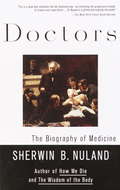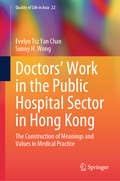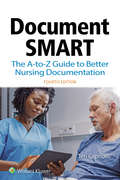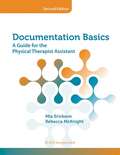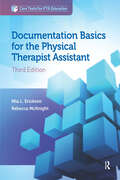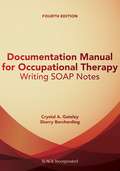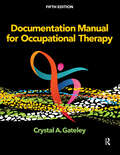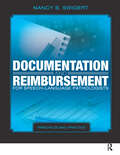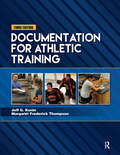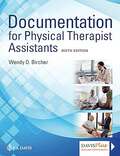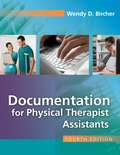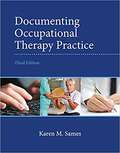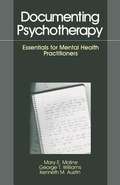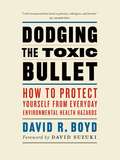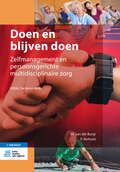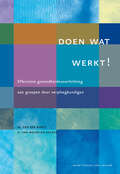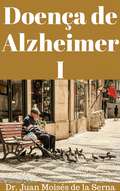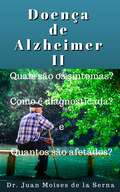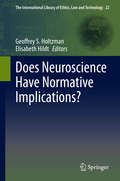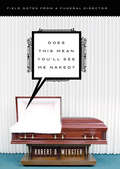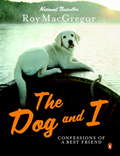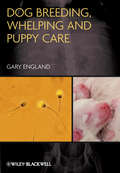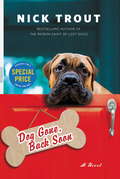- Table View
- List View
Doctors: A Novel
by Erich SegalBarney Livingstone and Laura Castellano are childhood neighbours who share an unforgettable friendship. From the crucible of med school's merciless training, through the demanding hours of internship and residency to the triumphs - and sometimes tragedies - of their daily professional lives, we follow Barney and Laura to unsettling celebrity and unsatisfying love . . . until their friendship ripens into passion.But they have yet to learn the ultimate lesson: that their devotion to each other, even their outstanding medical gifts, may not be enough to save the one life they treasure above all others . . .
Doctors: The Biography of Medicine
by Sherwin B. NulandHow does medical science advance? Popular historians would have us believe that a few heroic individuals, possessing superhuman talents, lead an unselfish quest to better the human condition. But as renowned Yale surgeon and medical historian Sherwin B. Nuland shows in this brilliant collection of linked life portraits, the theory bears little resemblance to the truth.Through the centuries, the men and women Who have shaped the world of medicine have been not only very human people but also very much the products of their own times and places. Presenting compelling studies of great medical innovators and pioneers, Doctors gives us the extraordinary story of the development of modern medicine -- told through the lives of the physician-scientists whose deeds and determination paved the way. Ranging from the legendary Father of Medicine, Hippocrates, to Andreas Vesalius, whose Renaissance masterwork on anatomy offered invaluable new insight into the human body, to Helen Taussig, founder of pediatric cardiology and co-inventor of the original "blue baby" operation, here is a volume filled with the spirit of ideas and the thrill of discovery. Says The New York Times, "Doctors can be warmly recommended. Dr. Nuland succeeds in bringing his subjects vividly to life, and he leaves you with a much better understanding of what they achieved."From the Trade Paperback edition.
Doctors’ Work in the Public Hospital Sector in Hong Kong: The Construction of Meanings and Values in Medical Practice (Quality of Life in Asia #22)
by Evelyn Tsz Chan Sunny H. WongThis book explores how public hospital sector doctors in Hong Kong understand their work and careers. Using narrative interviews with 27 medical doctors, the book examines how their personal values provide motivation and meaning for their work. How do they cope with the various hardships and crises they face in public hospitals? How can other doctors navigate similar issues in their own work? What should medical students know about the reality of medical work, as they stand poised to start their own career journeys? What should medical administrators know about work at the coal-face as they seek to tackle the problems the sector faces? This book offers a rare, personal window into doctors&’ views on their own work. The book also provides a useful resource for students and scholars in the fields of medical humanities, public health, the sociology of work, and narrative research.
Document Smart: The A-to-Z Guide to Better Nursing Documentation
by Theresa CapriottiFeeling unsure about documenting patient care? Learn to document with skill and ease, with the freshly updated Document Smart, 4th Edition. This unique, easy-to-use resource is a must-have for every student and new nurse, offering more than 300 alpha-organized topics that demonstrate the latest nursing, medical and government best practices for documenting a wide variety of patient conditions and scenarios. Whether you are assessing data, creating effective patient goals, choosing optimal interventions or evaluating treatment, this is your road map to documentation confidence and clarity.
Documentation Basics (Second Edition): A Guide For The Physical Therapist Assistant
by Mia Erickson Becky McKnightDocumentation Basics: A Guide for the Physical Therapist Assistant, Second Edition is the perfect guide for all physical therapist assistant students and clinicians who want to update and refine their knowledge and skills in documentation.
Documentation Basics for the Physical Therapist Assistant (Core Texts for PTA Education)
by Mia Erickson Rebecca McKnightComplete and accurate documentation is one of the most important skills for a physical therapist assistant to develop and use effectively. The new Third Edition of Documentation Basics for the Physical Therapist Assistant continues the path of teaching the student and clinician documentation from A to Z. Mia Erickson and Rebecca McKnight have updated this Third Edition to reflect changes in the ever-evolving profession. Newly addressed are the changes in documentation requirements for major payers, changes in the disablement models used, and the increasingly common use of electronic documentation in the physical therapy profession. Features inside the Third Edition: Readers are encouraged to think about disablement and disablement concepts when writing notes How to document impairments in body structure and function but more importantly activity limitations and participation restriction Descriptions of the differences in documentation methods using a computer vs paper chart Evidence tied to benefits and challenges of computerized documentation Documenting the rationale for treatment and the unique skills of the physical therapist assistant in patient management New inside the Third Edition: Incorporation of the International Classification of Functioning, Disability, and Health disablement model Chapter on electronic documentation Screenshot examples of the popular WebPT® electronic medical record platform Updated chapters on reimbursement and legal issues Additional examples for student practice included in each chapter Included with the text are online supplemental materials for faculty use in the classroom. Documentation Basics for the Physical Therapist Assistant, Third Edition is the perfect guide for all physical therapist assistant students and clinicians who want to update and refine their knowledge and skills in documentation.
Documentation Manual For Occupational Therapy: Writing SOAP Notes (Fourth Edition)
by Crystal Gateley Sherry BorcherdingOne of the most critical skills that occupational therapists must learn is effective documentation. With that idea in mind, Documentation Manual for Occupational Therapy: Writing SOAP Notes, Fourth Edition presents a systematic approach to a standard form of health care documentation: the SOAP note. The clinical reasoning skills underlying SOAP note documentation can be adapted to fit the written or electronic documentation requirements of nearly any occupational therapy practice setting. This new Fourth Edition has been updated to reflect current information essential to contemporary occupational therapy practice, including the AOTA's Occupational Therapy Practice Framework: Domain & Process, Third Edition. Documentation Manual for Occupational Therapy, Fourth Edition also includes the COAST method, a specific format for writing occupation-based goals. Crystal Gateley and Sherry Borcherding use a "how-to" strategy by breaking up the documentation process into a step-by-step sequence. Numerous worksheets are provided to practice each individual skill as well as the entire SOAP note process. In addition, examples from a variety of practice settings are included as a reference. Although this text addresses documentation in occupational therapy practice, the concepts can be generalized across other health care disciplines as well. New in the Fourth Edition: The chapter focusing on reimbursement, legal, and ethical considerations has been vastly expanded to provide an overview of sources of reimbursement, regulatory guidelines, and legal and ethical issues. A new chapter focusing on electronic documentation has been added to illustrate how the concepts presented in this text can be used in various electronic documentation software products. Faculty will have access to 12 videos that can be used for instructional purposes and documentation practice. This edition includes an expanded Instructor's Manual with sample quiz questions for several of the chapters, templates and grading rubrics for documentation assignments, and other instructional resources. Instructors in educational settings can visit www. efacultylounge. com for additional material to be used for teaching in the classroom. Documentation Manual for Occupational Therapy: Writing SOAP Notes, Fourth Edition presents essential documentation skills that all occupational therapy clinicians, faculty, and students will find critical for assessing, treating, and offering the best evidence available for their clients.
Documentation Manual for Occupational Therapy
by Crystal GateleyThe best-selling, newly updated occupational therapy textbook Documentation Manual for Occupational Therapy, Fifth Edition, is made for students and early-career practitioners learning the critical skill of documentation. The workbook format offers students ample opportunities to practice writing occupation-based problem statements and goals, intervention plans, SOAP notes, and other forms of documentation. The Fifth Edition has also been updated to reflect changes in the American Occupational Therapy Association’s Occupational Therapy Practice Framework: Domain and Process, Fourth Edition. What’s included in Documentation Manual for Occupational Therapy:• Numerous worksheets for students to practice individual skills with suggested answers provided in the Appendix• Updated information on coding, billing, and reimbursement to reflect recent Medicare changes, particularly in post–acute care settings• Examples from a variety of contemporary occupational therapy practice settings Included with the text are online supplemental materials for faculty use in the classroom. Instructors in educational settings can visit the site for an Instructor’s Manual with resources to develop an entire course on professional documentation or to use the textbook across several courses. One of the most critical skills that occupational therapy practitioners must learn is effective documentation to guide client care, communicate with colleagues, and maximize reimbursement. The newly updated and expanded Documentation Manual for Occupational Therapy, Fifth Edition, will help students master their documentation skills before they ever step foot into practice.
Documentation and Reimbursement for Speech-Language Pathologists: Principles and Practice
by Nancy SwigertAlthough it is the least noticed by patients, effective documentation is one of the most critical skills that speech-language pathologists must learn. With that in mind, Documentation and Reimbursement for Speech-Language Pathologists: Principles and Practiceprovides a comprehensive guide to documentation, coding, and reimbursement across all work settings.The text begins with section 1 covering the importance of documentation and the basic rules, both ethical and legal, followed by an exploration of the various documentation forms and formats. Also included are tips on how to use electronic health records, as well as different coding systems for diagnosis and for procedures, with an emphasis on the link between coding, reimbursement, and the documentation to support reimbursement.Section 2 explains the importance of focusing on function in patient-centered care with the ICF as the conceptual model, then goes on to cover each of the types of services speech-language pathologists provide: evaluation, treatment planning, therapy, and discharge planning. Multiple examples of forms and formats are given for each.In section 3, Nancy Swigert and her expert team of contributors dedicate each chapter to a work setting in which speech-language pathologists might work, whether adult or pediatric, because each setting has its own set of documentation and reimbursement challenges. And since client documentation is not the only kind of writing done by speech-language pathologists, a separate chapter on “other professional writing” includes information on how to write correspondence, avoid common mistakes, and even prepare effective PowerPoint presentations.Each chapter in Documentation and Reimbursement for Speech-Language Pathologists contains activities to apply information learned in that chapter as well as review questions for students to test their knowledge. Customizable samples of many types of forms and reports are also available.Included with the text are online supplemental materials for faculty use in the classroom.Documentation and Reimbursement for Speech-Language Pathologists: Principles and Practice is the perfect text for speech-language pathology students to learn these vital skills, but it will also provide clinical supervisors, new clinicians, and speech-language pathologists starting a private practice or managing a department with essential information about documentation, coding, and reimbursement.
Documentation for Athletic Training
by Jeff G. Konin Margaret Frederick ThompsonDocumentation for Athletic Training, Third Edition provides all the important and relevant information that a practicing athletic trainer needs to possess to provide accurate documentation. These topics include legal considerations, electronic medical records, and numerous tips for effective verbal and written communication styles. This Third Edition by Drs. Jeff G. Konin and Margaret Frederick Thompson continues to provide a plethora of standard templates to refer to as examples of the most commonly used forms in athletic training practice settings. The authors represent decades of collective experience as clinicians, educators, and administrators and offer insight on the importance of timely and appropriate methods for athletic training documentation.Documentation for Athletic Training, Third Edition has strengthened chapters on electronic documentation and documentation for reimbursement. These are continuously-evolving areas that require an understanding of not just a single type of software system, but rather a foundation of knowledge related to the principles of each. Additionally, a chapter has been added on contemporary type of documentation. Communication in the forms of text messages, social media, and other common types of information sharing are discussed. Features inside the Third Edition: Learning objectives for each chapter “Pearls of Wisdom” on key points Discussion and study questions Worksheets and commonly used documentation forms Glossary of terms Symbols and medical terminology abbreviations Documentation for Athletic Training, Third Edition continues to be the only textbook dedicated to the topic of documentation and presents a wide array of methods and forms, providing students, educators, and clinicians with a multifaceted tool box for their documentation needs.
Documentation for Physical Therapist Assistants
by Wendy D. BircherBuild your documentation skills—and your confidence. Step by step, this text/workbook introduces you to the importance of documentation to support quality patient care and appropriate reimbursement. It shows you how to develop and write a proper and defensible note; and prepares you to meet the technological challenges you’ll encounter in practice. <P><P> You’ll learn how to provide the proper documentation to assure all forms of reimbursement (including third party) for your services. You’ll also explore issues of patient confidentiality, HIPAA requirements, and the ever-increasing demands of legal and ethical practice in a litigious society.
Documentation for the Physical Therapist Assistant
by Wendy D. BircherBuild your documentation skills--and your confidence. Step by step, this text/workbook introduces you to the importance of documentation and shows you how to develop and write a proper and defensible note. You'll learn how to provide the proper documentation to assure all forms of reimbursement (including third party) for your services. You'll also explore issues of patient confidentiality, HIPAA requirements, and the ever-increasing demands of legal and ethical practice in a litigious society.
Documenting Occupational Therapy Practice
by Karen SamesA comprehensive guide to creating effective documentation in occupational therapy. <P><P> Documenting Occupational Therapy Practice, 3/e is the most comprehensive text on occupational therapy documentation currently on the market, covering general documentation principles, clinical documentation, electronic documentation, school system documentation, and documentation of administrative tasks. More than just a how-to manual, the text explores important ethical, legal, and language issues related to documentation in addition to presenting step-by-step strategies for creating successful SOAP notes, communications, and documentation. The Third Edition has been fully updated to reflect current AOTA official documents and new electronic documentation tools, and has been reorganized to improve readability. Effective review tools help readers truly master documentation techniques and strategies, while the text’s accompanying website provides additional learning resources that can be accessed on the go. <P><P> Teaching and Learning Experience This text offers a comprehensive guide to creating effective documentation for occupational therapy. It provides: Comprehensive coverage of all areas of practice: Chapters examine the underlying concepts of good documentation in clinical, school, and administrative settings. Practical techniques and strategies that prepare students for the workplace: Chapters present clear, effective strategies for drafting documentation and communication that can be directly applied in professional settings. Exploration of ethical and legal issues: Discussions help students understand how documentation affects others and provide problem-solving strategies for addressing legal and ethical issues. Coverage of electronic documentation: Screenshots and discussion of electronic health record (EHR) systems familiarize students with current documentation technologies. Effective learning tools: Review exercises and numerous reference tools help students truly master text material.
Documenting Psychotherapy: Essentials for Mental Health Practitioners
by Mary E. Moline George T. Williams Kenneth M. AustinAvoid malpractice for keeping inadequate records and be prepared to respond to a professional peer review by using Documenting Psychotherapy a practical volume that examines what is necessary to keep adequate records that meet current standards of care. This highly readable volume explores issues such as confidentiality, retention and disposition of records, documentation of safety issues, client access to records, treatment of minors, and the clinical record as it pertains to working with families, couples, individuals, and groups. Supervision and training issues are discussed in detail. Legal cases, vignettes, and professional commentary are used throughout the book to help guide the reader in thinking through legal and ethical situations
Dodging the Toxic Bullet
by David Suzuki David R. BoydDodging the Toxic Bullet presents workable strategies that show how we can live longer, healthier lives by breathing clean air, eating healthy food, drinking safe water, and using non-toxic products. Author David R. Boyd provides accessible background on a range of hazards including mercury in fish, carcinogens in cleaning products, lead in toys, and lethal E. coli in ground beef. His clear directions for reducing risk include growing lots of houseplants, choosing whole foods, avoiding consumer products with strong or long-lasting smells, and using green cleaning products. Easy-to-follow advice and informative sidebars and checklists make this a must-have guide, especially for parents of infants and children.
Doen en blijven doen: Voorlichting En Compliancebevordering Door Paramedici
by M. Burgt F. VerhulstDit boek helpt (aanstaande) zorgverleners om hun patiënten te coachen naar gezond gedrag en zelfmanagement. Het is bedoeld voor studenten van paramedische opleidingen, praktijkondersteuners van huisartsen en voor nascholingen van eerstelijns zorggroepen en ketenzorgpartners. Doen en blijven doen; Zelfmanagement en persoonsgerichte multidisciplinaire zorg beschrijft een aanpak die al in verschillende regio’s gebruikt wordt in ketenzorgprogramma’s. Deze aanpak gaat uit van een stappenmodel voor gedragsverandering. Op basis van de persoonsgebonden factoren kunnen zorgverleners hun begeleiding vervolgens persoonsgericht maken. Het boek gaat onder meer in op shared decision making, technieken uit de motiverende gespreksvoering en een zelfmanagementscreeningsinstrument. Doen en blijven doen is aantrekkelijk én eenvoudig toepasbaar dankzij praktijkvoorbeelden, interviews en video’s die de zelfmanagementondersteuning in de paramedische en multidisciplinaire eerstelijns praktijk illustreren. Dit is een herziene versie van Doen en blijven doen uit 2009. Deze herziene versie presenteert de actuele kennis over zelfmanagement, met extra aandacht voor laaggeletterden en ouderen en voor de multidisciplinaire samenwerking in de eerste lijn. Ook nieuw in deze uitgave is de beschrijving van lokale samenwerkingsverbanden rondom gezondheidsbevordering en preventie. Marieke van der Burgt is opgeleid als arts en voorlichtingsdeskundige in de gezondheidszorg. Ze werkte als docent in het hbo en mbo en geeft gastlessen en trainingen in begeleiding van gedragsverandering door eerstelijns zorgverleners. Daarnaast is ze auteur van boeken voor paramedici en verpleegkundigen.Frank Verhulst werkt als eerstelijns GZ-psycholoog. Verder is hij onder andere gastdocent gedragswetenschappen aan Fontys Paramedische Hogeschool en aan de Hogeschool Utrecht, Masteropleiding Psychosomatische fysiotherapie. Ook geeft hij lezingen en workshops over ‘de stappenreeks’ en de ‘persoonsgebonden factoren’.
Doen wat werkt !
by M. van der Burgt E. van Mechelen-GeversGezondheidsvoorlichting en –bevordering (GVO) en preventie vormen samen een specifieke verpleegkundige competentie. In deze praktische handleiding komen alle aspecten van (groeps)voorlichting aan bod. Het boek gaat uit van de huidige praktijk van gezondheidsvoorlichting door verpleegkundigen. Door de vele voorbeelden in dit boek kan elke verpleegkundige situaties en problemen uit de eigen beroepspraktijk herkennen. Er is gekozen voor een praktische benadering. Zo behandelt het boek de actiepunten voor het verzorgen van een voorlichtingsbijeenkomst en het ontwikkelen van een lokaal gezondheidsproject. Door de methodische benadering en het presenteren van evidence en good practice levert het boek een bijdrage aan de verdere professionalisering van de verpleegkundige op het gebied van gezondheidsvoorlichting. Voorbeelden en interviews maken de theorie van gezondheidsvoorlichting inzichtelijk en praktisch bruikbaar. Programmavoorbeelden, evaluatieformulieren en checklists zijn opgenomen als hulpmiddelen voor de verpleegkundige praktijk. Met dit boek kan de verpleegkundige direct aan de slag.
Doença de Alzheimer I
by Carlos Oliveira Juan Moises de la SernaO alzheimer é uma doença que tem crescido em relação ao número de casos de afetados nos últimos anos, o que por sua vez provoca o surgimento de muitas perguntas quando uma pessoa ou um familiar recebe esse diagnóstico, tal como: o que é o Alzheimer? Qual a sua origem? Existe tratamento? Como evolui a doença? Quais consequências acarreta na vida cotidiana? Quais são os efeitos psicológicos sobre o paciente? É possível superar? É transmissível para os filhos? Se abre diante de nós todo um leque de questões relativas à incerteza que é saber que padecemos com uma doença cada vez mais "comum" e estendida, e que apenas se sabe sobre os últimos avanços científicos nesta área, devido, em boa medida, à complexidade da linguagem técnica empregada. E também porque estes avanços tendem a chegar somente aos especialistas através de reuniões e congressos onde se compartilha esse tipo de informação.
Doença de Alzheimer II: Quais são os sintomas?, Como é diagnosticada? e Quantos são afetados?
by Cleiton Cândido da Silva Juan Moises de la SernaO objetivo do e-book é servir como uma primeira aproximação para aqueles que têm em si mesmos ou em sua família, a Doença de Alzheimer. Este livro tenta apresentar claramente os resultados das mais recentes pesquisas sobre a doença de Alzheimer, que respondem as perguntas mais importantes, o que provoca sintomas? Como é diagnosticado? Quantos afetados existem?
Does Neuroscience Have Normative Implications? (The International Library of Ethics, Law and Technology #22)
by Elisabeth Hildt Geoffrey S. HoltzmanThis book brings together a number of essays that are optimistic about the ways certain neuroscientific insights might advance philosophical ethics, and other essays that are more circumspect about the relevance of neuroscience to philosophical ethics. As a whole, the essays form a self-reflective body of work that simultaneously seeks to derive normative ethical implications from neuroscience, and to question whether and how that may be possible at all. In doing so, the collection brings together psychology, neuroscience, philosophy of mind, ethics, and philosophy of science. Neuroscience seeks to understand the biological systems that guide human behavior and cognition. Normative ethics, on the other hand, seeks to understand the system of abstract moral principles dictating how people ought to behave. By studying how the human brain makes moral judgments, can philosophers learn anything about the nature of morality itself? A growing number of researchers believe that neuroscience can, indeed, provide insights into the questions of philosophical ethics. However, even these advocates acknowledge that the path from neuroscientific is to normative ethical ought can be quite fraught.
Does Not Love
by James Tadd AdcoxSet in an archly comedic, alternate-reality Indianapolis that is completely overrun by Big Pharma, James Tadd Adcox's debut novel chronicles Robert and Viola's attempts to overcome loss through the miracles of modern pharmaceuticals. Their marriage crumbling after a series of miscarriages, Viola finds herself in an affair with the FBI agent who has recently appeared at her workplace, while her husband Robert becomes enmeshed in an elaborate conspiracy designed to look like a drug study.James Tadd Adcox's first book The Map of the System of Human Knowledge was published in 2012 by Tiny Hardcore Press. His work has appeared in TriQuarterly, the Literary Review, PANK, Barrelhouse, and Another Chicago Magazine.
Does This Mean You'll See Me Naked?
by Robert D. WebsterA funeral director reflects on 30 years of serving the living and deceased while providing us with a behind-the-scenes story told with both empathy and humor. He attempts to assuage our curiosity and answer those questions that are uppermost in our minds when faced with death, including: * How do you handle the loss of a loved one? * What really happens during a death call? * Why do people send flowers? * What occurs during the restoration process? * What do people leave in loved ones' caskets? * How has the undertaker's role evolved? * And much more...
Dog And I
by Roy MacgregorFrom Canada's beloved award-winning journalist and bestselling author comes a collection of essays, new and previously published, on man's best friend. In the course of 20 years of column writing about everything from politics to hockey and everything in between, Roy MacGregor has learned firsthand that the columns with the greatest reader impact have been those about the family dog. Roy has collected these columns and written many more on everything from puppy love to the sorrow of losing a pet, as experienced by Roy and the dogs he's known and loved.
Dog Breeding, Whelping and Puppy Care
by Gary EnglandA practical and up-to-date guide to canine reproduction for dog breeders, veterinary students and veterinary surgeons. Written in an easy-to-use style and presented in a practically useful format with clear illustrations. The information is supported by references from the author's published work and his wealth of clinical experience to form the important authoritative text in this field. A vital aid to those seeking an understanding of normal and abnormal reproduction as well as common reproductive techniques.
Dog Gone, Back Soon
by Nick TroutWhen Dr. Cyrus Mills returned home after inheriting his estranged father's veterinary practice, The Bedside Manor for Sick Animals, the last thing he wanted was to stay in Eden Falls, Vermont, a moment longer than absolutely necessary. However, the previously reclusive veterinarian pathologist quickly found that he actually enjoyed treating animals and getting to know the eccentric residents of the tiny provincial town-especially an alluring waitress named Amy. So Cyrus is now determined to make Bedside Manor thrive. Not an easy goal, given that Healthy Paws, the national veterinary chain across town, will stop at nothing to crush its mom-and-pop competitor. And the rival vet practice isn't Cyrus's only competition; a handsome stranger shows up out of nowhere who clearly has a mysterious past with Amy. To top it off, Cyrus finds himself both the guardian of a very unique orphaned dog and smack in the middle of serious small town drama.This charming sequel to The Patron Saint of Lost Dogs is a wild and delightful ride through one jam- packed week, where Cyrus must figure out how to outsmart the evil veterinary conglomerate, win back Amy's heart, solve several tricky veterinary cases, find a home for an orphaned dog, and detangle himself from an absurd case of mistaken identity. DOG GONE, BACK SOON brims with Nick Trout's trademark humor, charm, and captivating animal stories, and is proof that all dogs, lost or not, on four feet or two, deserve a second chance.
